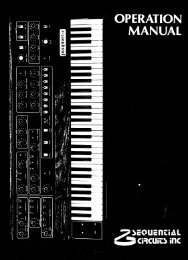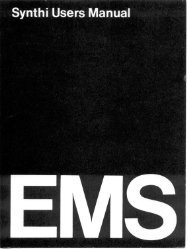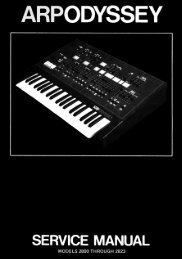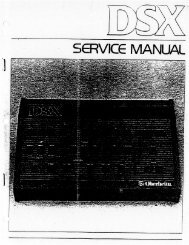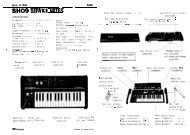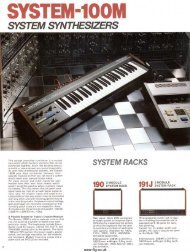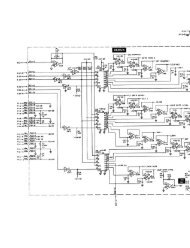ARP2600 - Fundamentals of Music Technology - Cyborgstudio.com
ARP2600 - Fundamentals of Music Technology - Cyborgstudio.com
ARP2600 - Fundamentals of Music Technology - Cyborgstudio.com
Create successful ePaper yourself
Turn your PDF publications into a flip-book with our unique Google optimized e-Paper software.
012 - SECTION TWO: VCO-1outputs is the only way the timbre can be changed. For instance,if one wishes to hear a square wave, one must connect the squareoutput <strong>of</strong> VCO-1 to the speakers. The only way to change thetimbre that VCO-1 is creating is to manually connect the patchcord to the saw output. It is important to also realize that bothoutputs <strong>of</strong> an oscillator can be used at the same time so that bothtimbres can be heard simultaneously.Although everyone will perceive timbres slightly differently, it ispossible to make some generalizations about them which willguide the student in his or her studies. The saw wave has lots <strong>of</strong>harmonics, and as such has a sound that sounds buzzy. The squarewave, on the other hand, has only the odd harmonics, and as such,it has a rather hollow sound. Take a moment now to listen to CDtrack 01. Several tones are played by VCO-1. First, the notes areFigure 2-1:VCO-1’s saw and square outputs.played with a square wave produced by VCO-1. Then, the notes are played with a saw wave producedby VCO-1. Remember to listen for the raw sound or timbre <strong>of</strong> the sound, and not how quickly orslowly the sound begins or ends.THE OSCILLATOR’S FREQUENCYThe second parameter <strong>of</strong> oscillators is frequency. Frequency is <strong>of</strong>ten referred to as pitch by musicians.While selecting a timbre is fairly simple, controlling frequency is a bit more involved. Frequency iscontrolled in several different ways. First, VCO-1 has a coarse frequency setting. This fader can changethe oscillator’s frequency over a very large range. It is possible to make the oscillator oscillate soquickly that it can’t be heard at all (a supersonic tone - 20 kHz or higher) or so slowly that a tone can’tbe perceived (a subsonic tone - 20 Hz or lower).When it is necessary to tune an oscillator to another source such as another oscillator, one needs betteroverall control than the coarse tuning slider can provide. This is the job <strong>of</strong> the fine tuning slider. (Theearliest version <strong>of</strong> the ARP 2600 lacked the fine tune control on VCO-1.) See page three for moreinformation.) The fine tuning slider increases or decreases the pitch a small amount from wherever ithas been set by the coarse tuning slider. When attempting to tune an oscillator to match another sourcesuch as another oscillator, one should get the frequency close to that <strong>of</strong> the other source using thecoarse slider, then tune it in perfectly using the fine tuning slider.As the oscillator’s tuning gets close to the pitch <strong>of</strong> the other source, a series <strong>of</strong> ‘beats’ can be heard.These beats are a sort <strong>of</strong> pulsing in the sound which occur when the waveforms <strong>of</strong> the two sourcesalternately cancel and reinforce each other. This results in a small change in volume which is perceivedas beats. As the frequency <strong>of</strong> the two sources gets closer and closer together, the beats will graduallyslow until finally, they stop, indicating that the two sources are perfectly in tune. Take a moment nowto listen to CD track 02. Two oscillators are being tuned together. Listen for the slowing <strong>of</strong> the beats asthey get closer to being in tune.




